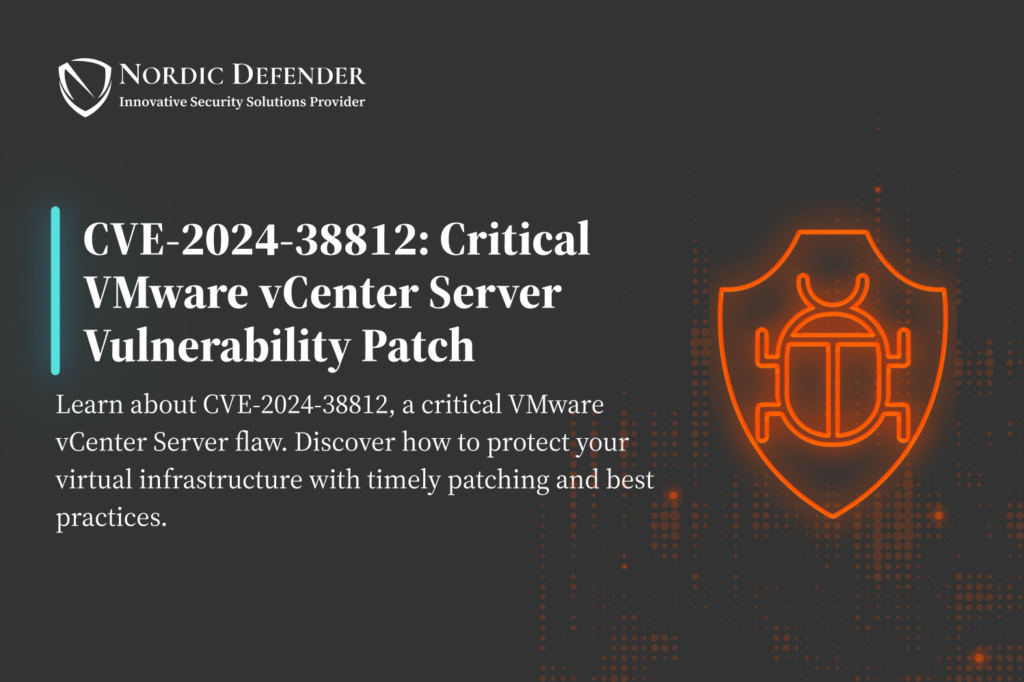In a recent security update, VMware addressed a series of vulnerabilities in its vCenter Server platform, with the most critical among them being CVE-2024-38812. This vulnerability, if left unpatched, poses significant risks to organizations leveraging VMware’s vCenter Server for managing their virtual infrastructure. Understanding the nature of CVE-2024-38812, its potential impacts, and the mitigation strategies is essential for enterprises looking to protect their systems from serious exploitation.
Understanding CVE-2024-38812: What’s at Stake?
CVE-2024-38812 is a severe vulnerability classified as a Remote Code Execution (RCE) flaw that affects VMware’s vCenter Server, a core component in managing and orchestrating virtual environments across enterprise networks. This vulnerability allows attackers to execute arbitrary code remotely, without needing prior authentication, granting them potential access to the server’s full capabilities.
Because vCenter Server sits at the heart of virtualized environments, a successful exploit of CVE-2024-38812 could enable threat actors to control the virtual machines (VMs), hypervisors, and data managed by vCenter. In a worst-case scenario, this could result in:
- Unauthorized Access to Virtual Infrastructure: Attackers could access sensitive data stored across the virtual environment, including customer records, intellectual property, and other critical assets.
- Full System Compromise: A remote code execution exploit could allow attackers to pivot from vCenter Server to other critical systems within the network, leading to broader compromises.
- Disruption of Operations: The ability to execute arbitrary code could be used to bring down entire data centers, crippling operational continuity for businesses reliant on virtualized infrastructure.
How Attackers Can Exploit CVE-2024-38812
The core danger of CVE-2024-38812 stems from its ability to be exploited remotely, bypassing authentication mechanisms. This means attackers could potentially target vulnerable vCenter Server instances exposed to the internet or accessible through unguarded network segments. If exploited, cybercriminals could implant malware, disrupt services, or even establish persistent backdoors for future attacks.
What makes CVE-2024-38812 particularly concerning is that the vulnerability requires minimal effort to exploit, making it an attractive target for both opportunistic hackers and advanced threat actors. The availability of public proof-of-concept exploits typically accelerates the timeline for widespread attacks.
The Importance of Timely Patching and Mitigation
With CVE-2024-38812 now publicly disclosed, the urgency for patching cannot be overstated. VMware has released security updates that address the vulnerability, and organizations are urged to apply these patches immediately. Delay in patching opens up a window of opportunity for cybercriminals to exploit the vulnerability, as unpatched systems become prime targets for attackers scanning for exposed systems.
Beyond simply applying the patch, security teams should also take the following steps:
- Limit Exposure of vCenter Server: Ensure that vCenter Server is not directly exposed to the internet. Segmenting the network and restricting access to vCenter Server can limit the potential entry points for attackers.
- Use Multi-Factor Authentication (MFA): Where possible, organizations should implement MFA to reduce the likelihood of unauthorized access, especially for administrative accounts tied to vCenter Server.
- Monitor for Suspicious Activity: Continuous monitoring of logs and network traffic is critical for detecting abnormal behavior that could indicate exploitation attempts or ongoing attacks.
Broader Implications of the CVE-2024-38812 Vulnerability
CVE-2024-38812 is not an isolated issue; it represents a broader challenge faced by enterprises as they scale their virtual environments. As organizations increasingly depend on virtualized infrastructure, the attack surface grows, making platforms like vCenter Server key targets for cybercriminals.
Furthermore, the interconnected nature of vCenter Server means that an attack on this platform could have ripple effects across an organization’s entire IT infrastructure. Threat actors exploiting CVE-2024-38812 could use their foothold in the virtual environment to compromise physical servers, storage systems, and even cloud-connected resources. This highlights the need for a holistic security approach, not just patching individual vulnerabilities but continuously assessing and securing the broader infrastructure.
Lessons Learned: The Vital Role of Proactive Security
The disclosure of CVE-2024-38812 underscores several important lessons for cybersecurity professionals:
- Regular Patch Management: While patching might seem like an obvious task, delayed updates are one of the most common reasons vulnerabilities are successfully exploited. Automated patch management tools can help ensure that updates are applied quickly across large environments.
- Defense-in-Depth Strategy: Relying solely on patching is not enough. Organizations need to adopt a defense-in-depth approach, which includes robust firewall configurations, network segmentation, regular security assessments, and layered access controls.
- Incident Response Planning: Preparing for the worst is essential. Organizations should have incident response plans in place that are regularly tested to ensure rapid recovery in case of an exploit. This includes conducting tabletop exercises that simulate a vulnerability exploit like CVE-2024-38812.
What’s Next for VMware Users?
VMware’s swift response in releasing a patch for CVE-2024-38812 demonstrates the importance of vigilance in software lifecycle management. However, it also raises questions about how enterprises can better secure their virtual environments going forward. As the cybersecurity landscape continues to evolve, vulnerabilities like CVE-2024-38812 will remain a recurring challenge.
For organizations using VMware, the key takeaway is clear: security is an ongoing process. It requires constant vigilance, timely updates, and an ever-evolving strategy to stay ahead of emerging threats. Enterprises that adopt this mindset will be far better positioned to protect their infrastructure, data, and operational continuity from future vulnerabilities.
By focusing on CVE-2024-38812, organizations are reminded that virtualized environments, while offering numerous benefits, come with significant security responsibilities. Applying patches, monitoring for threats, and adopting proactive security measures will help mitigate the risks associated with vulnerabilities like this, ensuring a more secure and resilient infrastructure.
